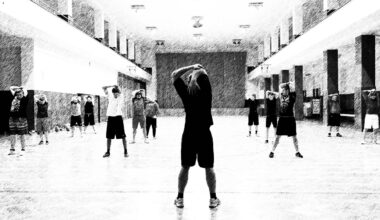The Role of the Core in Preventing Weightlifting Injuries
When engaging in weightlifting, understanding the significance of core stability is paramount. The core comprises not merely the abdominal muscles but also includes the obliques, rectus abdominis, and even the muscles surrounding the spine. A strong core provides a solid foundation for all kinds of physical activity, especially weightlifting, where stability is critical. Enhanced core strength aids in better posture, reduced injury risk, and improved lifting technique. Weak core muscles can lead to improper lifting mechanics, which may result in strains and injuries during workouts. Moreover, injuries are not just painful; they can hinder progress and lead to long-term challenges. Weightlifters need to incorporate core-specific stability exercises into their routine. These exercises help in developing endurance, allowing lifters to maintain stability even under heavy loads. Examples include planks, Russian twists, and stability ball exercises, each working various aspects of core muscles. Focusing on core engagement before lifting can significantly enhance performance and safety, translating into maximized gains from every session. Therefore, prioritizing core training strategies is vital for serious lifters aiming to stay healthy and injury-free.
Understanding Core Engagement During Lifts
Core engagement is crucial when executing any lift during weight training. Engaging the core means activating the muscles around your trunk, helping maintain a neutral spine throughout the movement. This aspect is especially relevant during compound lifts like squats and deadlifts, where improper mechanics can lead to injuries. Ensuring proper form demands that the core be braced adequately to support not just the weight being lifted but also to stabilize the entire body. Without this engagement, lifters compromise their body position, leading to imbalances and increased risk of injury. Furthermore, successful core engagement reinforces balance and coordination during lifts. It aids in transferring energy efficiently from the lower body to the upper body and vice versa, enabling smoother movement patterns. To practice core engagement, lifters can use various techniques, such as focusing on exhaling during exertion and tightening their core muscles as if preparing to absorb a punch. Training sessions should not ignore this principle for maximal effects. During every lift, the right core engagement not only protects injuries but enhances lifting efficiency, promoting overall success in weightlifting endeavors.
Core stability is not solely about lifting more weight; it involves ensuring safety through proper body support and control. Many lifters overlook this critical component, prioritizing heavier lifts at the expense of their core strength. A stable core allows the spine to remain aligned, providing the backbone needed for safe lifting. Research consistently shows that inadequate core muscle activation can lead to poor mechanical efficiency. Once mechanics are compromised, the risk for various injuries, including lower back pain, increases dramatically. In addition, strong core muscles help prevent over-reliance on other muscle groups, which can lead to strain and injuries. Therefore, lifters should emphasize core strength training consistently. Engaging in core-specific workouts can include Pilates, yoga, or specialized strength training movements designed to bolster these essential muscles. Moreover, tracking progress in core strength should be standard practice among lifters. By integrating core workouts into the fitness regimen, lifters increase their overall strength capacity while maintaining proper technique and form during lifts. Investing time in core stability pays off significantly in the long run, ensuring both short-term success and sustainable injury-free progression.
Essential Core Training Exercises
Incorporating essential core training exercises into a workout routine can help lifters understand the importance of this integral muscle group. Some of the most effective core exercises include planks, side planks, stability ball rollouts, and hanging leg raises. Planks are excellent for enhancing endurance and stability, while side planks require additional strength for lateral stabilization. Stability ball rollouts engage the entire abdominal wall while requiring awareness and control, perfect for developing a strong foundation. Hanging leg raises, while challenging, promote grip strength and core control, reinforcing back and hip engagement. Each exercise contributes uniquely to building strength, ensuring support during more complex lifts. Lifters should focus on maintaining proper form throughout each movement, avoiding substitutions with others that can lead to injury. Incorporating at least two to three core-focused workouts each week can yield noticeable improvements in overall physical performance. These workouts are not just about aesthetics; they contribute significantly to injury prevention and improved lifting mechanics. When athletes invest in their core strength, they create lasting change across their training sessions, ultimately enhancing their weightlifting journey significantly. Begin with basic movements, and steadily progress to more complex variations as strength develops.
Following a structured core training plan is crucial in developing the necessary strength to support lifting. This plan should focus on both dynamic and static exercises to cover all aspects of core conditioning. Static exercises are those where you hold a position, like the plank, while dynamic exercises involve movement, such as medicine ball throws. By alternating between these types, lifters engage different muscle fibers essential for stability and power. Additionally, incorporating varied workout intensities will challenge the core differently, leading to stronger development over time. It’s equally important to prioritize proper recovery periods, allowing the core muscles to recuperate and grow stronger, promoting sustainable strength gains. Ultimately, a well-structured core training plan allows weightlifters to maximize their potential and reduce the risk of injury during workouts. Lifters should assess their progress regularly and consider working with a coach or trainer to ensure their methods remain effective and safe. The integration of core work into lifting routines is increasingly being recognized by fitness professionals as an essential aspect to achieving optimal performance. Energy transfer during lifts, effective stability, and overall progress hinge on a lifter’s commitment to developing their core strength.
Monitoring and Adjusting Core Routine
As with any training aspect, evaluating your core training routine regularly is essential for developing strength and effectiveness. Lifters should utilize consistent testing methods to monitor core progress—this can include timed plank holds or measuring repetitions of specific exercises. Adjustments can be made based on performance outcomes, including increasing resistance or sets as strength improves. If certain movements start to feel easy, it may be time to progress to more advanced variations, ensuring that the core continues to be challenged effectively. Additionally, lifters must remain aware of their fatigue levels and how it impacts core engagement during lifts. Overworking the core can lead to fatigue, diminishing performance and increasing injury risk. Incorporating core work into the warm-up routine can also help pre-activate the muscles, creating a productive foundation for the lifting session. Listening to the body and understanding its limitations plays a key role in enhancing performance while safeguarding against injuries. With conscientious monitoring and tailoring of the core workouts, lifters can develop a resilient and powerful foundation for their weightlifting pursuits. Prioritizing this aspect fosters sustainable development and injury-free lifting workout sessions.
In conclusion, the role of the core is indispensable in preventing weightlifting injuries. Lifting without a strong foundation carries high risks, which can lead to burnout, injuries, and setbacks. By incorporating core-specific workouts, engaging in structured training plans, and prioritizing consistent monitoring, lifters can significantly enhance performance while minimizing risks. A well-developed core provides stability, enhances balance, and directly translates into improved lifting mechanics across various movements. Lifters can cultivate an injury-free routine by understanding how critical core engagement is. Investing in core strength is not only beneficial for maximized lifting performance but also promotes overall well-being throughout its training journey. So, begin integrating core exercises now, adopt a steady approach, and witness improvements. Remember, a resilient pioneer athlete does not overlook their core and always focuses on sustaining their health and performance. Professionals recognize the value of a stable core in longevity, allowing lifters to enjoy their fitness journey fully. Never underestimate the contribution a strong core makes to your weightlifting game; regular core workouts can be the difference between success and injury. Lift smart, lift safe by prioritizing your core in every training schedule.
Implementing core stability techniques not only safeguards against injuries but also enhances the overall experience of weightlifting. This commitment to core engagement leads to more productive workouts and better outcomes in competitive settings. In addition, it fosters a culture of awareness, encouraging lifters to mindfully approach every lift. As you refine your lifting craft, focus on core conditioning as an investment in your future in the sport. Balanced training not only enables short-term gains; it fundamentally transforms your approach to weightlifting, creating a safer and more sustainable journey toward personal fitness goals.


